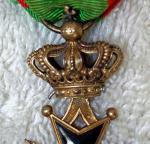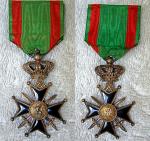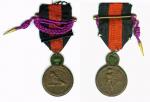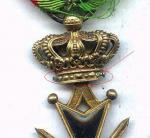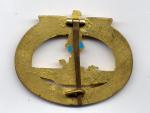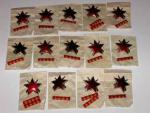
Tim B
Past Contributor-
Posts
2,234 -
Joined
-
Last visited
-
Days Won
2
Content Type
Profiles
Forums
Blogs
Gallery
Events
Store
Everything posted by Tim B
-
Unfortunately, I think the pin has been replaced (why??), but I see so few of these in PICS, I really can't tell as some appear to have this pin "head" showing as well. Thoughts?? Tim
-
While I'm here... Here is a quick PIC of my 2nd class medal. I am assuming with the "A" cipher, it is circa. WWI or thereabouts? Tim
-
Okay, I think I still follow you. Here, we have our four-year degree programs, whether you go to any civilian university or military academy, you come out basically as an O-1. An O-1 would be either an Ensign (Navy) or 2nd Lieutenant (other branches). Once they graduate, then they start their active military service and are usually obligated for 6 years. These are the ones that I would place into the second category (2) in my previous post. What about a guy that started out as an enlisted man, say he did 10 years service, then through one avenue or another was promoted into the officer ranks. From there, he did another 15 years service. I assume, at that point, he would be entitled to the 2nd Class award. If he remained in service, say another 10 years (35 years total military service and 25 years as an officer), would he then upgrade to the 1st class award. Can you actually do 35 years?? Tim
-
Thanks for that clarification Guy! I never assumed anything about a person being promoted into the officer ranks having a different award, but I guess that makes sense. We have our Warrant Officers, Limited Duty Officers, and regular Commisioned or Line Officers; the first two categories are strickly enlisted to officers programs where a non-com can be appointed into the officer grades. So, with that, then I assume: 1) The 2nd class would go more to a enlisted man that was promoted to officer rank and eventually reached 25 years faithful service overall? 2) The 1st class would go to a commisioned officer that was an officer from the very start? 3) What about a person in the first example (1) that remained in service long enough to attain 25 years as an officer? Does he then trade in his 2nd class award for a 1st class award, or wear both? Thanks again! Tim
-
Kriegsmarine Hilfskreuzer,Meybauer?
Tim B replied to Martin W's topic in Wehrmacht Medals, Decorations & Awards
Martin, Can we see PICS of the reverse? The front looks very nice; love the patina! Congrats! Tim :cheers: -
I can see Darrel is trying hard to get me to drag out my camera again! Tim
-
Here's an interesting commemorative coin that was recently on ebay, one that I haven't seen before. By the date, I am assuming that it deals with the passage of the conscription law that was passed in spite of the Versailles treaty. Can anyone decipher the reverse fully? First one I ever seen (and missed the auction). Anyone have one? Tim
-
Belgium Ijzer medal - Belgium / public thank you
Tim B replied to Stijn David's topic in Northern European & Baltic States
:beer: I see I will probably have to change the ribbon around (front to back), but it also has the black enamel bar! Tim -
The other question I have concerns the crown and how it attaches to the suspension. Here's a PIC showing what appears to be a pin placed in the base of the crown. Does this look like a replacement? Tim
-
Old thread, but just reading it now. Post #4 was very helpful and explains a lot on the different types seen. I do have a question though; How did you determine it was a 2nd class award without seeing the full suspension ribbon? My understanding is, these are strictly officer awards and time in service dictated which one was applicable. I thought...and honestly, I do not know...the 2nd class award (without rosette on the suspension ribbon) was for 15 years service and the 1st class award was for 25 years? Not a common item that I see very often. Tim Here's a sample of the 1st class award (not mine), but I'm looking for one. ;)
-
Belgium Ijzer medal - Belgium / public thank you
Tim B replied to Stijn David's topic in Northern European & Baltic States
Well James, Nothing more heard on the tip types, but I am going to take a chance and get this one as I just don't see these anywhere. Thanks for your thoughts and opinions on this!! Tim -
Yugoslavia Yugoslavian Partisan Stars
Tim B replied to Bryan's topic in Southern European & Balkan States
wlodzimierz, Hi, yes seen those two and was hoping I might find them cheaper. I got lucky the other day getting a nice Albanian Partisan Star 1st Class for the same price. :jumping: -
Kriegsmarine The Ultimate U-Boat Badge
Tim B replied to Gordon Williamson's topic in Wehrmacht Medals, Decorations & Awards
Hey Erik! Good to see it went to a great home! Doreen had said it sold at a show, might have been confused, who knows. Glad you got it! Tim -
Yugoslavia Yugoslavian Partisan Stars
Tim B replied to Bryan's topic in Southern European & Balkan States
Beautiful! Any idea what I should pay these days for a nice IKOM 3rd Class star? I do see a couple advertised, but the seller is usually considered high-end in his pricing. Congrats! Tim -
Yugoslavia Yugoslavian Partisan Stars
Tim B replied to Bryan's topic in Southern European & Balkan States
Almost makes you want to cry, doesn't it? Imagine how little he probably paid for all these back then. Oh well, somebody has to get lucky. Tim -
Kriegsmarine The Ultimate U-Boat Badge
Tim B replied to Gordon Williamson's topic in Wehrmacht Medals, Decorations & Awards
Always liked the badge, just that pit on the reverse held me up from buying it originally. Oh well... Tim -
Kriegsmarine The Ultimate U-Boat Badge
Tim B replied to Gordon Williamson's topic in Wehrmacht Medals, Decorations & Awards
Hi Gordon, Yes, as expected. I actually almost picked one of these up years ago and didn't and believe it or not, the dealer had a very hard time getting rid of it. When I did go for it, they had just sold it at one of the big Geman shows in 2005. Tim -
Hi Dieter, Believe this is the current style of the Sacred Treasure. Here's a link for you: http://www8.cao.go.jp/english/decoration/index.html Tim :beer:
-
Yugoslavia Yugoslavian Partisan Stars
Tim B replied to Bryan's topic in Southern European & Balkan States
Concur, better to start small and expand once we have a base to start with. Here's a potential "type" of problem: A member over at the Soviet Awards Page Forum had posted these from 2006 when he bought them all from a seller. Stated most were in the 8000-9000 or 17000 range, but didn't elaborate how many were in what specific group. All 3rd class. Tim -
Kriegsmarine The Ultimate U-Boat Badge
Tim B replied to Gordon Williamson's topic in Wehrmacht Medals, Decorations & Awards
That's one nice looking badge! Gordon, by chance, do you know if it had a round wire or flat stock style catch? I would "assume" with it being cutout, the badge was probably manufactured earlier and had the round wire "C" type catch. What about the hinge? Barrel or block? Curious. All these Junckers are nice, great looking badges! Tim -
Yugoslavia Medal for Bravery
Tim B replied to wlodzimierz's topic in Southern European & Balkan States
This is one of the things about ebay that makes collecting harder; here the person has 100% good feedback as a seller with 893 total to his/her name and now you wonder just how many items they sold are total crap!? How is a new collector supposed to defend against this without help through GOOD references and forums such as this? Tim -
Yugoslavia Yugoslavian Partisan Stars
Tim B replied to Bryan's topic in Southern European & Balkan States
That might be helpful as this thread is pretty old already. We could start a new thread similar to those in other areas just asking for serial numbers, or documented cases (I/e: award cert/star) and start compiling a list of numbers vs dates. Go from there? Unfortunately, mine is without any documentation and that might be the case of the majority here, still we could update the numbers found in collections. Are we going for the Mondvor or Ikom or both? Tim -
I was under the impression mine was the 1904-05 variety, but now see it is not. So with that bit of information then, I assume the piece had to be made later on during some "wartime" period as it's made from aluminum? On the bow; did all period red cross member medals use a bow? I know on some higher grades they used a cross-shape rosette, but what about regular member's medals? If I look at decorations; Meiji era used ribbon bows and Showa era used round rosettes, but are these Red Cross awards different? Thanks again! Tim
-
Larry, I think I see now; got this from another site that was down and now back up: http://p2.hostingprod.com/@imperialjapanme....com/index.html Regular membership medal. Silver color, usually aluminum. Dated Meiji 21 [1888]. Note that this date is used for all Red Cross medals from 1888 to 1945. Russo-Japan War Commemorative medal. Bronze color; unknown metal. Dated Meiji 37-8 [1904-5].
-
Hi Larry, I was trying to go off: http://www.xavierb.net/japan/ (need Java to open it) Looking at his site; I was under the impression that mine was of the 1904-05 coinage. I see where he states that aluminum was used during the "war years" and also later in the 40's. His pictures are too small to read the Kanji clearly, but are the reverse dates not the same (1904/05)? After reading his write-up, I assume the 1904-05 issue to be an authorized award. He calls the bronze colored one, a variation or commemorative that was without ribbon. The women's medal he shows is actually silver, not bronze like the one you show. Tim

